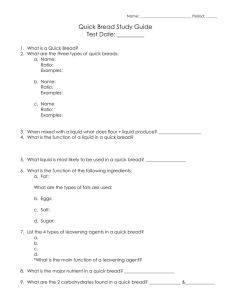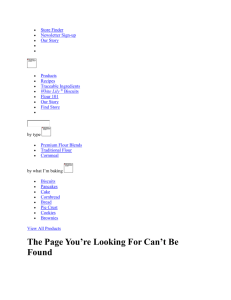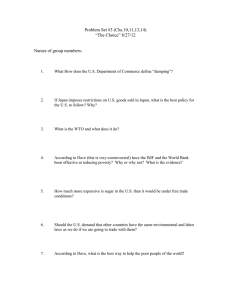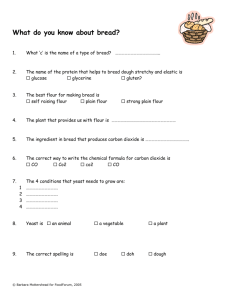Research Journal of Applied Sciences, Engineering and Technology 5(1): 224-227,... ISSN: 2040-7459; e-ISSN: 2040-7467
advertisement
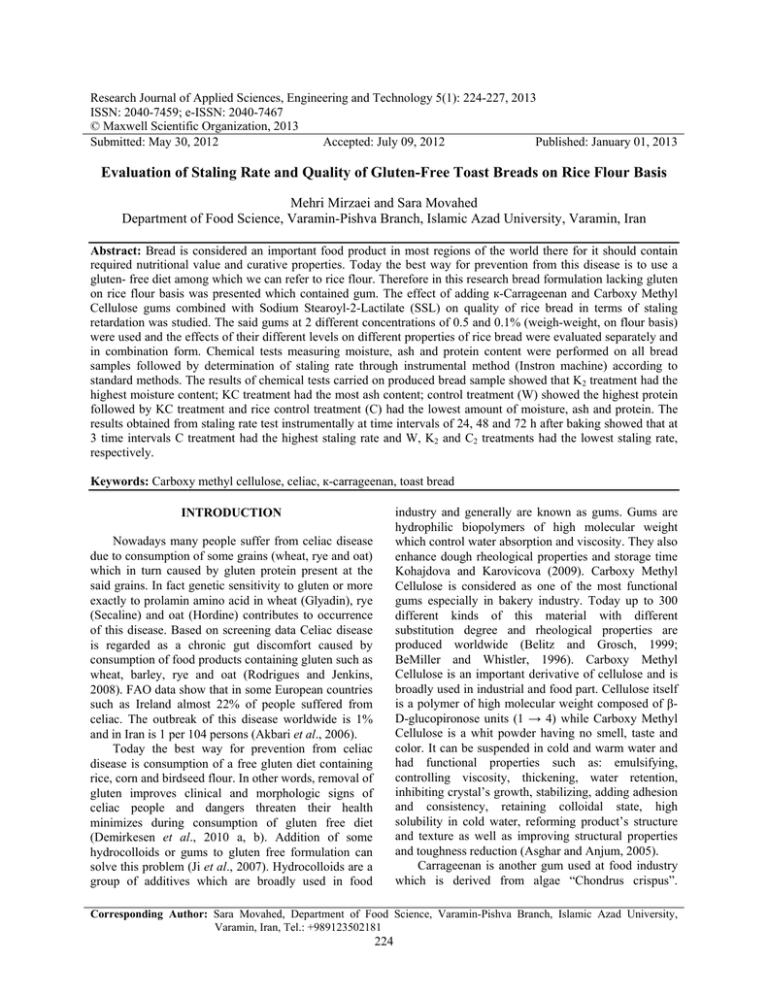
Research Journal of Applied Sciences, Engineering and Technology 5(1): 224-227, 2013 ISSN: 2040-7459; e-ISSN: 2040-7467 © Maxwell Scientific Organization, 2013 Submitted: May 30, 2012 Accepted: July 09, 2012 Published: January 01, 2013 Evaluation of Staling Rate and Quality of Gluten-Free Toast Breads on Rice Flour Basis Mehri Mirzaei and Sara Movahed Department of Food Science, Varamin-Pishva Branch, Islamic Azad University, Varamin, Iran Abstract: Bread is considered an important food product in most regions of the world there for it should contain required nutritional value and curative properties. Today the best way for prevention from this disease is to use a gluten- free diet among which we can refer to rice flour. Therefore in this research bread formulation lacking gluten on rice flour basis was presented which contained gum. The effect of adding к-Carrageenan and Carboxy Methyl Cellulose gums combined with Sodium Stearoyl-2-Lactilate (SSL) on quality of rice bread in terms of staling retardation was studied. The said gums at 2 different concentrations of 0.5 and 0.1% (weigh-weight, on flour basis) were used and the effects of their different levels on different properties of rice bread were evaluated separately and in combination form. Chemical tests measuring moisture, ash and protein content were performed on all bread samples followed by determination of staling rate through instrumental method (Instron machine) according to standard methods. The results of chemical tests carried on produced bread sample showed that K2 treatment had the highest moisture content; KC treatment had the most ash content; control treatment (W) showed the highest protein followed by KC treatment and rice control treatment (C) had the lowest amount of moisture, ash and protein. The results obtained from staling rate test instrumentally at time intervals of 24, 48 and 72 h after baking showed that at 3 time intervals C treatment had the highest staling rate and W, K2 and C2 treatments had the lowest staling rate, respectively. Keywords: Carboxy methyl cellulose, celiac, к-carrageenan, toast bread industry and generally are known as gums. Gums are hydrophilic biopolymers of high molecular weight which control water absorption and viscosity. They also enhance dough rheological properties and storage time Kohajdova and Karovicova (2009). Carboxy Methyl Cellulose is considered as one of the most functional gums especially in bakery industry. Today up to 300 different kinds of this material with different substitution degree and rheological properties are produced worldwide (Belitz and Grosch, 1999; BeMiller and Whistler, 1996). Carboxy Methyl Cellulose is an important derivative of cellulose and is broadly used in industrial and food part. Cellulose itself is a polymer of high molecular weight composed of βD-glucopironose units (1 → 4) while Carboxy Methyl Cellulose is a whit powder having no smell, taste and color. It can be suspended in cold and warm water and had functional properties such as: emulsifying, controlling viscosity, thickening, water retention, inhibiting crystal’s growth, stabilizing, adding adhesion and consistency, retaining colloidal state, high solubility in cold water, reforming product’s structure and texture as well as improving structural properties and toughness reduction (Asghar and Anjum, 2005). Carrageenan is another gum used at food industry which is derived from algae “Chondrus crispus”. INTRODUCTION Nowadays many people suffer from celiac disease due to consumption of some grains (wheat, rye and oat) which in turn caused by gluten protein present at the said grains. In fact genetic sensitivity to gluten or more exactly to prolamin amino acid in wheat (Glyadin), rye (Secaline) and oat (Hordine) contributes to occurrence of this disease. Based on screening data Celiac disease is regarded as a chronic gut discomfort caused by consumption of food products containing gluten such as wheat, barley, rye and oat (Rodrigues and Jenkins, 2008). FAO data show that in some European countries such as Ireland almost 22% of people suffered from celiac. The outbreak of this disease worldwide is 1% and in Iran is 1 per 104 persons (Akbari et al., 2006). Today the best way for prevention from celiac disease is consumption of a free gluten diet containing rice, corn and birdseed flour. In other words, removal of gluten improves clinical and morphologic signs of celiac people and dangers threaten their health minimizes during consumption of gluten free diet (Demirkesen et al., 2010 a, b). Addition of some hydrocolloids or gums to gluten free formulation can solve this problem (Ji et al., 2007). Hydrocolloids are a group of additives which are broadly used in food Corresponding Author: Sara Movahed, Department of Food Science, Varamin-Pishva Branch, Islamic Azad University, Varamin, Iran, Tel.: +989123502181 224 Res. J. Appl. Sci. Eng. Technol., 5(1): 224-227, 2013 Carrageenan derived from seaweed can’t be absorbed body, i.e., it lacks nutritional value but it has many functional properties such as jell formation, moisture control and texturizer. The said gum contains 3 isolated parts including kappa, landa and yuta. к-carrageen’s structure composed of 4-sulfat galactos units and 3, 6anhydro-D-galactose and it has more usage in bakery industry than the other 2 parts so that it enhances product’s volume and texture in flour preparations (Gekko et al., 2002; Mezaize et al., 2009). Emulsifiers are other additives that have functional properties too. Sodium Stearoyl-2-Lactilate (SSL) is an emulsifier used for Kneading the dough, enhancement of dough’s ripening tolerance, enhancement of read’s softness as well as increase of water retention capacity and bread’s volume (Onyango et al., 2009). Lee and Lee (2006) evaluated the effect of xanthan gum on rice bread and found that addition of 1% xanthan led to decrease of bread’s toughness and increase of shelf life Lee and Lee (2006). The aim of this research is evaluation of staling rate and quality of gluten-free toast breads on rice flour basis. MATERIALS AND METHODS Rice flour was obtained from Amol Khazar Khusheh Company; Carboxy Methyl Cellulose and кCarrageenan were prepared from Dowchemical Company; toast bread’s preparations were purchased from Sahar Bread Company and dried bakery yeast was obtained from yeast making company (Fariman, Mashad). In all tests, 0.5% к-Carrageenan gum treatmetn was signified with K1 code; 1% кCarrageenan gum treatmetn was signified with K2 code; 0.5% Carboxy Methyl Cellulose gum treatment was signified with C1 code and 1% CMC gum treatment was signified with C2 code; 0.5% Carboxy Methyl Cellulose and 0.5% к-Carrageenan gums treatment was signified with KC code; control treatment: Was signified with C code; control treatment Was signified with W code This research has been done in Islamic Azad University of Varmint and Tehran University in 2011. Chemical test of flour and bread samples: Chemical tests carried on rice flour with 3 replications included moisture (according to international standard of AACC, 44-16), ash (AACC, 08-01) and protein (AACC, 4612). Also chemical tests carried on bread samples included moisture, ash and protein according to aforesaid standard methods Anon (2003a, b). Determining tread’s staling rate through instrumental method by Instron: In order to determine staling rate of bread samples, Instron machine was used according to AACC, No. 74-09. This test was performed at time intervals of 24, 48 and 72 h after baking. In doing so samples were stored at plastic bags at ambient temperature followed by cutting crumb slices with dimensions of 2×2 Cm for measurement of staling by Instron machine. Compression exerted equals to 40% of samples’ diameter (Anon, 2003a). Preparation and baking procedure of bread: Raw materials (rice flour, Saccaromysis Cerivisiae, sugar, liquid oil and toast bread preparations) were prepared and weighted for marring toast. Carboxy Methyl Cellulose gum at different concentrations of 0.5 and 1% was then added to rice flour followed by mixing in dough-making tank for about 10 min. Other powdery and dried materials were added to the obtain mixture. Water was added to the mixture and complete mixing of water and flour led to formation of a flexible dough. After initial rest of dough samples for 10 min, dough slices weighted 800 g were divided and rounded. An additional resting for 10 min was done followed by medial fermentation. Dough divisions were the transferred to fermentation chamber and final fermentation was allowed for 40 min at 30°C and 80% RH. Finally bread moulds were transferred into relative oven at 180°C. Baking time of toast bread samples was about 4-5 min. After baking, bread samples were removed from moulder, cooled for 30 min at room temperature and packed with polypropylene bags Lazaridou et al. (2007). Statistical analysis: Statistical analysis was done using SPSS software (version 10) and Duncan’s multiple range tests was used for mean comparison. RESULTS Table 1 show results of chemical tests of wheat flour and rice flour and Table 2 show results of mean comparison of chemical tests on toast bread. In each column means which have a common letter are not significantly different based on Duncan’s test (α = 1%). Table 1: Results of chemical properties of rice flour and wheat flour Moisture Ash Protein Flour (%) (%) (%) Fat (%) pH Rice flour 8.7 0.48 9.56 0.88 5.3 Wheat flour 10.26 0.68 10.61 1.66 5.7 Table 2: Results related to mean comparison of chemical test data in toast bread (%) Treatment Moisture Ash Protein K1 32.23d 1.293c 8.34c K2 39.20a 1.343c 8.35c 33.98c 1.403b 8.30d C1 35.01b 1.463b 8.35c C2 1.693a 8.99b KC 33.38c 1.153e 8.22e C 29.75e 1.240d 9.71a W 30.68e 225 Res. J. Appl. Sci. Eng. Technol., 5(1): 224-227, 2013 Table 3: Results related to mean comparison of staling measurement of toast bread samples by Instron Time (h) K1 K2 C1 C2 KC 24 34.81e 17.69c 18c 9.67b 23.83d 48 39.14e 19.09c 19.61c 14.48b 25.77d 22.40c 21.52bc 18.75b 26.87d 72 41.42e Results related to staling test performed by Instron: Staling test through mechanical (instrumental) method was performed 24, 48 and 72 h after bake, respectively. For doing so, toast bread samples were placed at plastic bags separately and after codifying, they were stored at room temperature. In order to determine staling by Instron, some portions of crumb were cut at dimensions of 2×2 cm. Table 3 indicates the results of mean comparison and analysis of variance obtained from staling measurement of toast bread samples by mechanical method. In each raw means which have a common letter are not significantly different based on Duncan’s test (α = 1%). DISCUSSION Results obtained from chemical test showed that rice flour containing 8.7 moisture and 9.56 proteins was suitable for rice bread making according to Iran national standard No. 11136. The effect of different levels of CMC and к-Carrageenan gums on moisture percent of toast bread samples. As you can see from Table 2 addition of gums led to increase in moisture content. K2 and C2 had the highest moisture content, respectively while control samples had the lowest moisture (p<0.01). Increased moisture observed at gum-containing bread samples is due to high waterholding capacity of gums’ structure. These results are in line with findings of Rosell et al. (2001) who reported that moisture content was increased with gum addition. Based on results shown at Table 2 ash content of the samples was increased by gum addition. KC showed the highest ash content as well as a significant difference with the other treatments where as control sample (W) had the lowest ash content. These results are in accordance with those of Brites et al. (2008) who reported that gum addition caused an increase in ash content (Brites et al., 2008). Gum addition led to increase of protein content of gum-containing samples compared with control (C) while the highest protein content was related to control (W) followed by KC. C had the lowest protein content. Compared with C sample is presence of protein and some amino acids at gums. These finding agree with results of Brites et al. (2008) which reported that protein content of gumcontaining samples was increased due to presence of protein and carbohydrates at gums incorporated. Also increase in protein content of wheat toast bread compared with rice to as bread is attributed to higher amount of protein in wheat flour compared with rice flour Brites et al. (2008). Based on Table 3, gum addition led to decrease in staling rate at 3 time C 36.43f 43.05f 48.33f W 6.65a 8.18a 8.33a intervals of 24, 48 and 72 h after bake compared with C. (W) showed the lowest staling rate as well as a significant difference with the other treatments followed by K2 and C2 treatments. Rice control sample (C) had the most staling rate. Based on results shown at Table 3, addition of CMC and к-Carrageenan gums to rice bread formulations led to decrease in staling rate during 3 days after baking bread. In addition, 72 h after bake E treatment showed the lowest staling rate followed by C1 and C2 while rice control sample (C) had the most staling rate. Decrease in staling rate of gum-containing samples is attributed to incorporated gums which led to enhancement of dough’s elasticity and consequent softness of the obtained breads compared with control breads. These results are in line with findings of Mezaize et al. (2009) who reported that addition of gums to gluten-free bread’s formulation led to softer crumbs. CONCLUSION Results showed that adding к-Carageenan and CMC gum at concentrations of 0.5 and 1% had different effects on staling rate and chemical parameters of produced toast breads. The results of chemical tests carried on wheat flour and rice flour showed that consumed flour was suitable for toast bread making. The results of chemical tests carried on produced bread sample showed that K2 had the highest moisture content; KC had the most ash content; control (W) showed the highest protein followed by KC and rice control (C) had the lowest amount of moisture, ash protein. The results obtained from staling rate test instrumentally at time intervals of 24, 48 and 72 h after baking showed that at 3 time intervals C had the highest staling rate and W, K2 and C2 had the lowest staling rate, respectively. REFERENCES Akbari, M.R., A. Mohammadkhani, H. Fakheri, Z.M. Javad, B. Shahbazkhani, M. Nouraie, M. Sotoudeh, R. Shakeri, et al., 2006. Screening of the adult population in Iran for Celiac disease: Comparison of the antibody and anti-endomysial antibody tests tissue-transglutaminase. Eur. J. Gastroenterol Hepatol., 18(11): 1181-1186. Anon, 2003a. AACC Standard: Approved Methods of Analysis of the American Association of Cereal Chemists. St. Paul. MN, USA. Anon, 2003b. ICC Standard: Methods of International for Cereal Chemistry. 226 Res. J. Appl. Sci. Eng. Technol., 5(1): 224-227, 2013 Asghar, A. and F.M. Anjum, 2005. Effect of carboxy methyl cellulose and gum arabic on the stability of frozen dough for bakery products. Food Hydrocoll., 29: 237-241. Belitz, H. and W. Grosch., 1999. Polysaccharides. In: Belitz, H. and W. Grosch (Eds.), Food Chemistry. Springer, Berlin, pp: 237-318. BeMiller, J.N. and R.L. Whistler, 1996. Carbohydrate. In: Fennema, O.R. (Ed.), Food Chemistry. Marcell Dekker Inc., New York, pp: 206-218. Brites, C., M.J. Trigo, C. Santos, C. Collar and C.M. Rosell, 2008. Maize Based Gluten-free bread: Influence of processing parameters on sensory and instrumental quality. Food Bioproc. Technol., 3(5): 707-715. Demirkesen, I., B. Mert, G. Sumnu, S. Sahin, 2010a. Rheological properties of gluten-free bread formulations. J. Food Eng., 96(2): 295-303. Demirkesen, I., B. Mert, G. Sumnu, S. Sahin, 2010b. Utilization of chestnut flour in gluten-free bread formulations. J. Food Eng., 101(3): 329-336. Gekko, K., H. Mugishima and S. Koga, 2002. Effects of sugars and polyols on the sol-gel transition of kcaarageenan: Calorimetric study. Int. J. Biol. Macromolecules, 9(3): 146 -152. Ji, Y., K. Zhu, H. Qian and H. Zhou, 2007. Staling of cake prepared from rice flour and sticky rice flour. Food Chemistry, 104(1): 53-58. Kohajdova, Z. and J. Karovicova, 2009. Application of hydrocolloids az baking improvers. Chem. Pap., 63(1): 26-38. Lazaridou, A., D. Dutab, M. Papageorgiouc, N. Belcb and C.G. Biliaderis, 2007. Effects of hydrocolloids on dough rheology and bread quality parameters in gluten-free formulations. J. Food Eng., 79(3): 1033-1047. Lee, M. and Y. Lee, 2006. Properties of gluten-free rice breads using different rice flours prepared by dry: Wet and semi-wet milling. Food Eng. Prog., 10(3): 180-185. Mezaize, S., S. Chevallier, A.B. Le and M. de Lamballerie, 2009. Optimization of gluten-free formulations for French-style breads. J. Food Sci., 74(3): 140-146. Onyango, C., G. Unbehend and M.G. Lindhauer, 2009. Effect of cellulose-derivatives and emulsifiers on creep-recovery and crumb properties of gluten-free bread prepared from sorghum and gelatinized cassava starch. Food Res. Int., 42(8): 949-955. Rodrigues, A.F. and H.R. Jenkins., 2008. Investigation and management of coeliac disease. Arch. Dis. Child., 93(3): 251-254. Rosell, C.M., J.A. Rojas and C.B. de Barber, 2001. Influence of hydrocolloids on dough rheology and bread quality. Food Hydrocoll., 15(1): 75-87. 227



